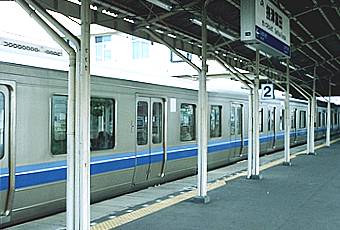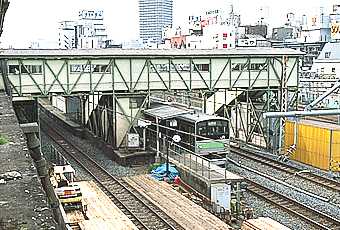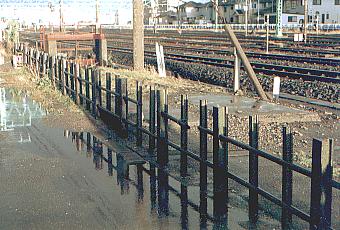| In Japan, the first railroad
transportation service was started between Shimbashi Station at Tokyo and
Yokohama Station in 1872, and the 2nd service was started between Osaka
Station and Kobe Station in 1874.
The rails laid at these
times were i-rails made of wrought iron. Flat-bottom rails (made of
wrought iron) were laid on the railroad between Kyoto Station and Osaka
Station which were opened to the 3rd in 1878. First steel rails (laid i-rails
again) were laid in the 4th railroad section between Otsu Station and Kyoto
Station in 1880. Subsequently, steel flat-bottom rails are being laid on
the railroad of Japan, including the Shinkansen (= the Bullet Train).
As for early rails in Japan, the import rails from
Europe and USA were laid. Rolling of rails in Japan was
started in 1901, in the Steel Works at Yawata in Kyushu by Japanese
government. Since rails by domestic product were insufficient at first,
Japanese made rails and import rails were used by mix to 1926-27. Present,
rails for railroads of Japan are provided only by the domestic product.
They are rolled in the Yawata Works of NIPPON
Steel Corporation and the Fukuyama Plant (in the West Japan Works)
of JFE Steel Corporation. In
these, the rails for export are also contained, besides rails laid in Japan.
Used old rails were recycled to various facilities
in Japan by reasons, such as the oriental custom of economizing any things
(known that it is "Mottainai") or the supply shortage caused from World
War II. They were widely recycled as materials for the
roofs of platform in station, the overpasses crossing tracks, the fences
stabbing to the ground and the others. Those many are colored with
paint for rust prevention. Therefore, it is possible to research old rails
in Japan, because a large number of rails are still existing and being
recycled. By the way, the rails laid for first railroad in Japan are still
existing and are British rails which were printed "+
DARLINGTON IRON Co 70 IGJR". Since such stamps are
printed on web (/ side) of rails, we can get various informations about
the makers, the manufacture years, also the clients, etc. from rails. By
this method, the rails of 10 nations and about 90 makers are being discovered
in Japan.
The act of recycling these rails became obsolete
quickly by the 1970s. It is considered to be some reasons as H-shape steels
which are used for construction materials became more cheaply to receive,
as the quality of rails was improved (by increasing the ratio of the carbon
contained in steel) so that it could not bend easily, and as rails became
larger and heavy. In recent years, the constructions installing elevators
and escalators in stations, and the constructions remaking stations to
be able to utilize from the both sides of railroad tracks by laying over
them (railroad tracks) are often performed in Japan. It generally follows
on these constructions, buildings which recycled old rails are removed.
Therefore, it is more necessary to hurry to record old rails being recycled
by them currently.
At the researching of old rails in Japan, "The
introduction for hobby-research of rails" which were reported 3 times in
1977 by NISHINO Yasuyuki and FUCHIGAMI Tatsuo on "the Railway Pictorial"
of a Japanese railroad hobby magazine, are existence like textbook (its
supplements were added another 3 times). They are reporting about rails
found in Japan as some outlines of history, some comments about makers,
some guesses to the clients, and some considerations. Although a quarter
of a century passed, and various changes and new discoveries also are continuing,
articles authorizing old rails are nearly not being published after that.
Therefor, I investigate and record old rails, and
do classifying and evaluating of them. And, I open their results to the
public by the webpage of the Inter-net. |
![[cutted] R??NGTON IRO? Co 70 IGJR](rail/darlin70.jpg)
![[cutted] R??NGTON IRO? Co 70 IGJR](rail/darlin70.jpg)




